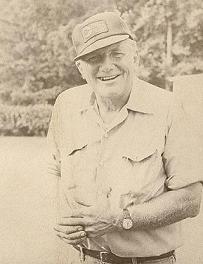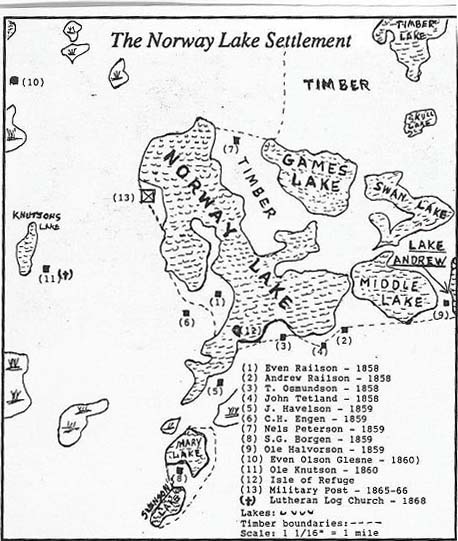Mankell Family History
"Why the Dakota loved Kandiyohi County"
written by Orlynn Mankell

Storyteller and historian, Orlynn Mankell
From West Central Tribune, December 23, 1987:
During the series on the Dakota war, the accounts have mentioned the Dakota Indian and his dispossession and some information on how this bitter conflict reached up into Kandiyohi County. It is on this phase of the conflict that a couple of intriguing questions seem to remain.
The Willmar area is a good 40 miles from the Minnesota River Valley, the main areas of the hostilities. Why would a part of it suddenly shift 40 miles to the north? Why all this sudden attention directed toward Kandiyohi County by the Dakota war parties during those turbulent days in August of 1862? There probably are some good reasons.
Extending across the width of northern Kandiyohi County is a two- to four-mile-wide band of the original hardwood forest. It runs from east to west for over 25 miles and directly within it are such familiar places as Sibley State Park, county parks on Games Lake and Green Lake, and at the western end, about a mile into Swift County, Monson Lake State Park.
This area always figured prominently in the life of the aboriginal hunter and then, much later, in the life of the Dakota tribesmen. Still found are his old campsites, the trails between them, and the many artifacts he left behind him. Even today parts of the original "forest primeval" are still found, which look pretty much the same as when this early hunter silently stalked his deer through it centuries ago.
Over the years, this forested region took on more and more importance for the Dakota tribes. In the 1700s, they were being gradually pushed farther and farther west by their eastern hereditary enemies, the Ojibway (or Chippewa). As mentioned before, the Dakota were routed by the Ojibway in 1750 at the Battle of Kathio near Mille Lacs Lake and it would be from then on that the Dakotas would assume this traditional image we have of them as being roamers and dwellers of the plains and prairies.
But here in Kandiyohi County there still remained a part of their original forest and it was still under their control. And they let it be widely known that this area was strictly "off limits" to any Ojibway. To enhance this region even further, there runs along the southern edge of this woodland a chain of lakes and this certainly also played a prominent role in the life of the Dakota. Here, after long, severe winters, was a quickly available food supply, as fish would move up these freshened meltwater creeks and channels to spawn.
Then, directly to the south of the lakes, were the prairies. For centuries, prairie fires had been running directly up to the lakes from the southwest. As a result, lakes such as Norway and Andrew are open to the south. But on the north side, away from these fires, the forest has been growing and reseeding itself for hundreds of years. Even today the routes of these ancient fires can be traced.
Out on these prairie areas were the herds of buffalo. In 1800, a hunter moving through the area had some interesting options. He could be hunting deer in the dense forest, and then move a mile or two south or north to be directly out in buffalo habitat. And when he wasn't hunting, he could watch as the large herds converged on the south shores of Andrew and Norway for their evening fill of water.
For the Dakota tribes, especially after 1750, this was an important and valuable land -- even a "coveted" land. In that entire area going west into Montana (referred to later by some as the Sioux nation), it is doubtful any other area quite compared with it. Where else could you hunt deer on one side of a lake and buffalo on the other? And it probably explains why much of central and northern Kandiyohi County would be bitterly contested at a time still years ahead.
The forces of change being what they were in this country in the 1800s, and with this constant unrelenting pressure of the white man advancing west, much of central and western Minnesota was ceded away by the Dakota chiefs in the treaties of 1851. The pressures were great that they should sell. And with it went all those lands we know today as Kandiyohi County.
There would be a long delay, however, for the white man to claim his new lands. There would be the required surveying first. The Dakota Indian was now committed to live in designated areas along the Minnesota River, but he would soon notice that there seemed to be no visible change in his former lands. It wasn't long before he was once again around the lakes, watching from Mount Tom for some distant buffalo herd and living for long periods of time at Henderson Lake (a favorite place). But then in 1858, the first white settler cabin appeared along the west shore of Norway Lake. There was no longer any doubt. The white man was coming for his land.
Then there was a second cabin followed by another and yet another until, by 1860, that early and historic Norway Lake First Settlement was in place. It comprised eight or so hardy and intrepid families, all from Norway and all pre-emptors (before the homesteaders). What had caught their attention about the area was how the prairies ran directly up to the lakes from the south, and on the west side of the lake -- right in the three-way junction of lake, woodland and prairie -- was where the cabin would come up. Soon there were eight families living on seven lakes. The main part of the farm, however, was the prairie, which lay to the south and west of the cabin.
Other frontier settlements were coming into place as well. As for the Dakota Indian, he was now getting a good look at how his lands were now being taken over by the white man's culture. But there was one overriding question: "Where are the payments for our lands?" It was a question that would be asked with an ever increasing bitterness. And at Henderson Lake Chief Little Crow had some sharp comments for an early frontier pastor, Andrew Jackson, as to who actually owned the ground the two were standing on at the moment.
The Dakotas continued to come up from the Agency into Kandiyohi County, to hunt, to fish, and at times, it seems, just to be there, to be around their old familiar places -- and very possibly to be temporarily away from the demeaning and barren existence at the Agency. But for the hunter, things had been changing during the 1850s. The buffalo herds were scarce and had been retreating to the west. The last recorded sighting of a buffalo herd in Kandiyohi County was in 1858.
The buffalo were gone, but in the forest the deer remained. On a day late in the fall of 1860, a small party of Dakota hunters, numbering around four or five, was proceeding along a small pristine lake in northern Kandiyohi County, and through a pleasant grove of oak and ash. Presently, they found themselves standing out in front of the new log cabin belonging to Swen and Margit.
Swen's claim was one of these lakeside farmsteads of the first Norway Lake settlement. And his particular lake was Lake Mary. The record would state that a large expedition of Dakota hunters, numbering over 300, would pass through the settlement this fall. Whether this small party of hunters was part of the larger group is unknown. The hunters were probably just a little hesitant as they stood around outside the cabin.
This was probably not the first visit of this type, nor would it be the last, but it is this one which always seems to stand out just a little bit. And it would be all because of Swen's wife, Margit. Sometime during the course of the visit, she was standing directly among them, guns, hatchets and all, and was soon presenting to them a quantity of food of some kind. It is generally believed to be bread, but just how much is unknown.
As these early Kandiyohi County deer hunters left Swen's cabin, it is probably regrettable that they would leave no record of their impressions of the visit. As they discussed it among themselves -- as they almost certainly would have to have done -- they would all have to agree that this Margit was certainly a brave woman to directly approach them like this. But chances are Margit didn't consider it being brave at all.
This long-ago visit to Swen and Margit's place would seem to show that, at least one white household, the American Indian was well received -- and that traditional Norwegian hospitality was already firmly in place along Lake Mary.

Map of Norway Lake Settlement, noting Swen Gunderson Borgen cabin, and Lake Mary
The Mankell homestead is about 1.25 miles east of the Borgen/Swenson homestead (where the word "Borgen" is written on the map). Source: Keeping the Faith...Sharing the Faith
Note from Carolyn Sowinski: The writer of this article was my father. Early settlers Swen and Margit Borgen were my great-great-great-grandparents.
Orlynn's articles about Kandiyohi County history:
- Why the Dakota loved Kandiyohi County
- Gunder Swenson, Norwegian Settler
- Thomas and Bergit Osmundson
- Pioneer Woman: Anne Christopherson Olson Holter
- Lonely Gravestone Tells of Pioneer's Fate: Johannes Iverson
- 1863 Drought in Kandiyohi County
- Norway Lake Pioneer (Sven Borgen) Endured Drought of 1863
- Threshing Machine
- Lake Florida Mission Church